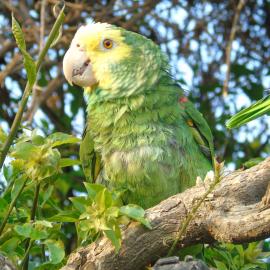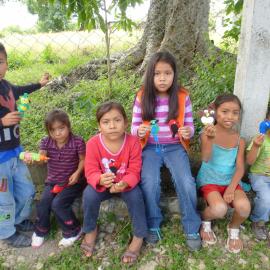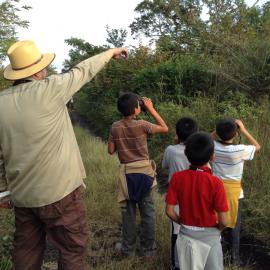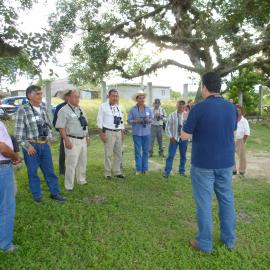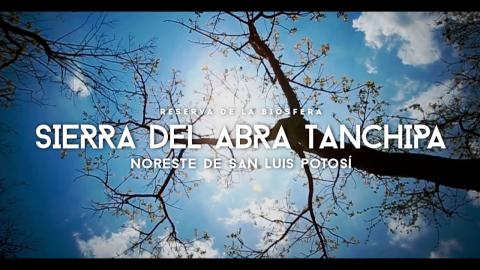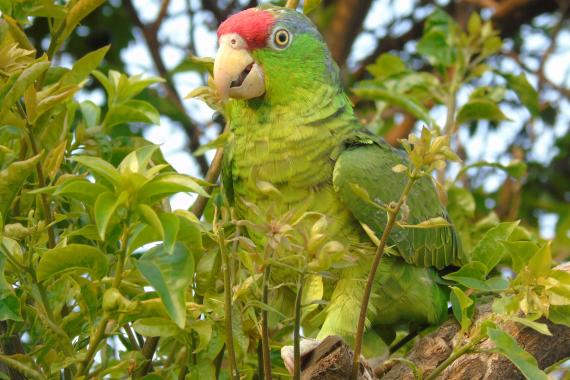
Red-Crowned Amazon (Amazona viridigenalis). Credit: IGOBA / Francisco Javier Sahagún Sánchez
Since 2013, Incidencia y Gobernanza Ambiental (IGOBA) has been working in Sierra del Abra Tanchipa Biosphere Reserve to design a Community Bird Monitoring Programme (CBMP) intended to generate mechanisms to involve neighbouring communities in the conservation activities implemented in the reserve. The CBMP has provided important information on the richness and diversity of bird species in the reserve. Poaching has reduced in some communities, who are now working together to keep out poachers who previously invaded their lands in search of parrots.
Lead
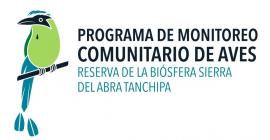
Location
Sierra del Abra Tanchipa Biosphere Reserve
The poaching and wildlife trade problem
Species affected Green Parakeet Psittacara holochlorus , Military Macaw Ara militaris , Olive-throated Parakeet Eupsittula nana , Red-crowned Amazon Amazona viridigenalis , Red-lored Amazon Amazona autumnalis , Yellow-headed Amazon Amazona oratrix
Products in tradeLive animals illegally traded as pets
Overview of the problem
In Mexico, parrots have historically been subjected to overexploitation due to poaching, driven by the heavy demand in the pet market at local, national and international level.
Individual birds are captured, often by local people. In local communities, between one and three parrots and/or parakeets are commonly found per household.
The anti-IWT initiative
Since 2013, the organisation Incidencia y Gobernanza Ambiental (IGOBA) has been working with the Management Board of the Sierra del Abra Tanchipa Biosphere Reserve to design a Community Bird Monitoring Programme (CBMP) intended to generate mechanisms to involve neighbouring communities in conservation activities implemented in the reserve.
The CBMP specifically works to raise awareness of the importance of conserving parrots in their wild state. Community partners were invited from the beginning to take part in the various stages of programme design.
A number of courses have been held, covering training on data collection as well as the importance of avian biodiversity, key factors in bird identification, monitoring techniques and data-processing. Participants have also been trained in the use of citizen science portals.
At the same time, conservation activities have been publicised and awareness has been raised on the importance of avoiding, and reporting, any illegal trade in parrots at the local level. Educational outreach programmes have focused on sustainability and on promoting a conservation culture. In 2015, a web site was developed to promote the CBMP and share the outcome of research and monitoring activities. The website functions as a citizen science portal, enabling online consultation of monitoring records.
Inclusion of gender, age and ethnic groups
This is an inclusive project that does not discriminate against groups, with activities generally open to the public. However, most of the community partners involved in daily monitoring tend to be either elderly or teenage men. By contrast, capacity-building courses on conservation and sustainability are attended mainly by women and children. Since local communities are largely made up of Mestizo people, the involvement of specific ethnic groups such as the Tenek or Nahua is limited, although the programme is open to them.
The strategy
Strengthening disincentives for illegal behaviour
Monitoring and surveillance activities are carried out by community partners. Funds have been used to pay daily wages and purchase field equipment.
The programme has encouraged the training of youth groups in environment-related activities, and as a result some young people have taken part in monitoring activities. In these cases, the provision of materials for field activities – bird-watching guides and even binoculars, placed on indefinite loan to the users – have served as an incentive.
Awareness-raising activities among local communities include the production of printed matter that stress the importance of getting involved in actions to combat the poaching of parrots, parakeets and macaws, and set out the fines and penalties to which poachers are liable. Useful information is provided on anonymous reporting of poachers, together with the contact details of programme staff in order to facilitate rapid intervention.
Increasing incentives for wildlife stewardship
On several occasions we have thought about implementing a bird-watching tourism programme in the region, focussing on species of ornithological interest. This is seen as a development opportunity, as attracting visitors might generate income for local people.
Over the last few years, the Laguna del Mante District has received funding through a Payments for Ecosystem Services scheme, promoted by the National Forestry Commission. This has sparked the interest of local people in biodiversity conservation, given that they might benefit financially from providing environmental services.
Another idea suggested is the creation of a Wildlife Conservation Management Unit, focussing on the local presence of species such as the Wild Turkey (Meleagris gallopavo) and the White-Tailed Deer (Odecoileus virginianus), which might generate income through controlled hunting.
Decreasing the costs of living with wildlife
Increasing livelihoods that are not related to wildlife
The reserve's Management Board, operating through the Conservation for Sustainable Management Programme (PROCODES) has promoted economic activities intended to replace those with a high environmental impact. A good example is the implementation of a honey-production project in the La Aguaje community, which involved capacity-building and support for the purchase of inputs needed for bee-keeping, with a view to halting the expansion of livestock-raising activities and avoiding the changes in land use which these entail.
Other projects currently in a preliminary development phase include the initiative of a women's group to embroider fabrics. It is hoped that this project will be supported by appropriate funding, giving rise to an alternative source of income and also a new means of gender empowerment.
In the Laguna del Mante District, community authorities have been working for some years with the Reserve's Management Board to restore an estate currently known as the Centre for Conservation Culture, which boasts a Museum of Natural Sciences and Ethnography, as well as lecture theatres, workshops and spaces for cultural activities and community meetings.
Build/and or support sense of community ownership or stewardship
Further detailThe various activities implemented are aimed at building a sense of identity and ownership, and at encouraging the adoption of a conservation culture by communities in and around the reserve. The CBMP has designed an image which appears in its logo, featuring one of the best-known and most popular local species: the Blue-Capped Motmot (Momotus coeruliceps).
Work is currently under way to develop mechanisms to enhance biodiversity governance in order to strengthen the sense of community ownership and empowerment. The recently-created Reserve Advisory Council seeks to ensure the engagement of all actors in the taking of conservation and management decisions affecting the reserve, which will help to raise awareness and stimulate joint stewardship with community partners.
Improving education and awareness
Further detailA recently-drafted project proposal for an environmental-education agenda aimed at communities in the reserve focuses on sustainability and conservation culture. It seeks to raise awareness regarding the importance of the landscape and wildlife elements to be found in the reserve; to foster a sense of environment ownership based on an eco-social approach to public and community involvement in conservation-oriented activities in the reserve; and to encourage the adoption of improved natural-resource management practices as a means of ensuring sustainable regional and local development. The project will be implemented over the next few months.
Has the initiative made a difference?
The CBMP has provided important information on the richness and diversity of bird species in the reserve. Monitoring activities have shed considerable light on various aspects of the ecology of the parrots, and this information has been included in a publication aimed at the general public, which sets out numerous reasons why communities should commit themselves to the conservation of these species.
Ranch owners have been encouraged to maintain any lands that have not been environmentally degraded and urged to turn them into Voluntary Conservation Areas. It is hoped that this approach will enhance habitat connectivity for these species.
Computer graphics and guide books have made it easier to communicate with local people, many of whom have rallied to the cause and now share information with their peers. The impact of the programme is particularly apparent among local children, whose attitude towards wildlife conservation has improved significantly.
Local communities are working together to keep out poachers who previously invaded their lands in search of parrots, reducing poaching rates in some communities. However, there is still some poaching by local people, whose peers are afraid to report them of fear of possible reprisals.
What works and why
Active participation and leadership on the part of the programme's promoters have been crucial to its smooth running. The commitment of IGOBA and the reserve's Board of Management are proving essential to its progress and consolidation.
The production of technical and promotional material has helped us to share the knowledge gained under the programme, at the same time enhancing awareness-raising activities among local people, enabling them to identify the species in need of conservation in the area.
It has been essential to forge links with other programmes and organisations with a view to sharing experiences and identifying alternative potential sources of funding.
Factors for success
Sufficient time investment in building relationships and trust between the initiative and local communities
Devolved decision-making power so local communities have a voice in creating or co-creating solutions (as part of the initiative)
Transparent and accountable distribution of benefits to local communities
The development of the programme required a considerable investment of time and resources, in order to ensure a smooth working relationship between the various actors and representatives of those sectors which influence land use. Their involvement in the programme's design and implementation gave added legitimacy to the initiative. The production of physical material containing relevant information has helped to raise awareness and elicit a positive response in local communities. Daily wages are paid through community authorities, in accordance with rules drawn up by the District Committee, which has helped to guarantee transparency and accountability with regard to the way funds are used.
What doesn’t work and why
The lack of regular, reliable funding has had a marked impact on the continuity of project activities, at times limiting project implementation. A constant flow of funding should be ensured by securing a larger number of sources, in order to guarantee continuous, sustainable financing.
Changes taking place within institutions have led to the reformulation of programmes, as unscheduled changes in operating rules have had a major effect on programme implementation. This in turn has hindered the securing of funding for the programme, which has seriously undermined its continuity.
There is a lack of institutional capacity (insufficient staff, financial and organisational resources, etc.) for responding to complaints regarding trafficking in the area. Community monitors, moreover, are unable to intervene directly in some cases of poaching. An alternative model or regulatory framework is required, which could allow other authorities to intervene, thus making it possible to arrest and subsequently charge poachers.
Another factor that could undermine the successful implementation of programmes is the rotation of official district authorities. If a new district commissioner is not committed to the reserve's conservation goals, this may significantly impair project outcomes.
Factors that limited or hindered success
Lack of long-term donor support that is flexible, adaptive and/or based on realistic time goals
Ineffective and/or untrustworthy community leaders
Unclear and intangible benefits to local communities from wildlife (These may be financial and/or non-financial)
In some cases, partners and project leaders have been deprived of support due to changes in institutional policy. A good example was the cancellation, in 2017, of the Endangered Species Conservation Programme, which provided funding for the conservation of the reserve's parrots.
In some communities, local authorities systematically rejected all institutional conservation-linked activities in their area, thus hindering the implementation of project initiatives, while in others, the replacement of office-bearers delayed project progress, due to the need to raise the awareness of incoming officials.
Finally, stress should be placed on the need to involve more people in conservation-related issues and in the fight against poaching. More effort should be made to implement collective learning processes with a view to raising awareness of the benefits to be derived from conserving habitats and the species living in them.
Organisers, donors and partners
Board of Management, Sierra del Abra Tanchipa Biosphere Reserve
National Commission on Protected Natural Areas
University of Guadalajara
National Autonomous University of Mexico
Autonomous University of San Luis Potosí
German International Cooperation Agency (GIZ) in Mexico
Mexican Nature Conservation Fund
Birds of Mexico Museum
For further information contact Francisco Javier Sahagún Sánchez (incidencia.ambiental@gmail.com).
